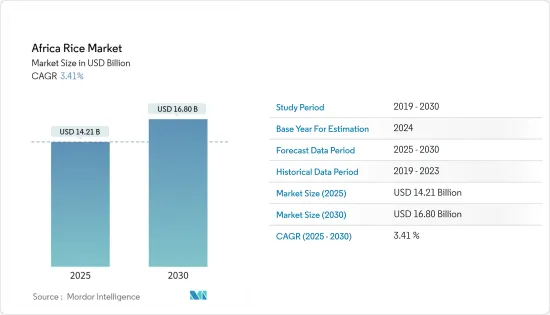
|
市場調査レポート
商品コード
1687070
アフリカの米:市場シェア分析、産業動向・統計、成長予測(2025年~2030年)Africa Rice - Market Share Analysis, Industry Trends & Statistics, Growth Forecasts (2025 - 2030) |
||||||
カスタマイズ可能
適宜更新あり
|
|||||||
| アフリカの米:市場シェア分析、産業動向・統計、成長予測(2025年~2030年) |
|
出版日: 2025年03月18日
発行: Mordor Intelligence
ページ情報: 英文 93 Pages
納期: 2~3営業日
|
全表示
- 概要
- 目次
アフリカの米市場規模は2025年に142億1,000万米ドルと推計され、予測期間(2025-2030年)のCAGRは3.41%で、2030年には168億米ドルに達すると予測されます。

主なハイライト
- 米はアフリカで重要な主食として台頭しており、その需要は1990年の約1,000万トンから2023年には4,000万トンを超えるまでに急増しています。この増加は、急速な人口増加と食生活の進化によるところが大きく、特に米からのカロリー摂取量が7%から9%に増加したことに起因しています。収量の向上にもかかわらず、アフリカの米生産は需要に遅れをとっており、その結果、輸入への依存度が高まっています。ITC Trade Mapによると、アフリカ大陸の米需要の20%以上は輸入でまかなわれており、主に東南アジアとインドから供給されています。このような外部供給源への依存により、アフリカは供給の途絶や価格変動の影響を受けやすくなっています。
- アフリカでは、米の栽培は主に零細農家によって行われています。一方、大規模な企業や商社が生産量の約10%を占めています。この地域の主な米生産国は、ナイジェリア、コートジボワール、マダガスカル、マリ、タンザニアです。これらの国々は米栽培に適した気候条件に恵まれているが、国内消費の増加は主に輸入によって満たされています。特に西アフリカでは消費者の嗜好が大きく変化しているため、この地域の需給バランスが崩れ、米市場の成長を後押ししています。
アフリカの米市場動向
域内の生産ポテンシャルの拡大
ほとんどのアフリカ諸国は、消費者の間で高まる米の需要を満たすために輸入に大きく依存しています。しかし、いくつかの研究を通じて集中的な米栽培が導入されたことで、調査期間中に国内生産量は増加しました。地域全体の生産性が一貫して低水準であることから、アフリカ地域の米生産に適した土地のマップを作成するため、国際応用システム分析研究所(IIASA)によって世界農業生態学的地帯(GAEZ)分析作業が開発されました。これにより、稲作に適した土地の特定が可能となり、稲作の生産が促進されました。
国連食糧農業機関(FAO)によると、アフリカの米生産量は2019年から2022年の間に3,640万トンから3,980万トンに増加しました。この増加は、農家が灌漑に投資し、精米業者が零細農家と契約栽培を行って籾を調達したことに起因します。こうした活動は農家に安定した収入をもたらし、この地域の米生産を押し上げています。アフリカにおける新しい農業慣行の採用は、同地域の国内米供給と市場成長をさらに促進すると予想されます。
コートジボワールは米の主要輸入国のひとつ
コートジボワールでは、中間所得層からの需要の高まりにより、主食としての米の需要が増加しています。零細農家が同国の主要な米生産者であり、人口増加により国内の米消費量は着実に増加しています。しかし、国内生産量は国内消費量の50%に過ぎず、コートジボワールは輸入に大きく依存しています。米部門は現在、非正規で断片的、非効率的であり、その結果、輸入米に対する競争力を欠いています。
ITC貿易マップのデータによると、2023年、コートジボワールは130万トンの米を輸入し、世界最大級の米輸入国となっています。2025年には国内消費を満たすために200万トンの精米が必要になると推定されています。コートジボワールは主にインド(59万4,600トン)、ベトナム(48万9,700トン)、パキスタン(10万300トン)、タイ(5万9,700トン)、中国(4万5,200トン)から米を輸入しています。人口の増加と消費者の食生活の嗜好の進化に伴い、米の需要は今後数年間で増加すると予想されます。
その他の特典:
- エクセル形式の市場予測(ME)シート
- 3ヶ月間のアナリストサポート
目次
第1章 イントロダクション
- 調査想定と市場定義
- 調査範囲
第2章 調査手法
第3章 エグゼクティブサマリー
第4章 市場力学
- 市場概要
- 市場促進要因
- 市場抑制要因
- バリューチェーン分析
第5章 市場セグメンテーション
- 地域別(生産量分析、消費量・金額分析、輸入量・金額分析、輸出量・金額分析、価格動向分析)
- 南アフリカ
- ガーナ
- ナイジェリア
- コートジボワール
- カメルーン
- マダガスカル
- ニジェール
- コートジボワール
- セネガル
- ギニアビサウ
- タンザニア
第6章 市場機会と今後の動向
The Africa Rice Market size is estimated at USD 14.21 billion in 2025, and is expected to reach USD 16.80 billion by 2030, at a CAGR of 3.41% during the forecast period (2025-2030).

Key Highlights
- Rice has emerged as a crucial staple in Africa, with demand surging from about 10 million metric tons in 1990 to over 40 million metric tons in 2023. This increase is largely attributed to rapid population growth and evolving dietary habits, notably a rise in caloric intake from rice, from 7% to 9%. Despite yield improvements, Africa's rice production lags behind demand, resulting in increased dependence on imports. According to ITC Trade Map, over 20% of the continent's rice demand is met through imports, primarily sourced from Southeast Asia and India. This dependence on external sources renders Africa vulnerable to supply disruptions and price fluctuations.
- In Africa, rice cultivation is predominantly undertaken by smallholder farmers. In contrast, large-scale firms and trading companies contribute about 10% to the total production. The region's primary rice producers are Nigeria, Cote D'lvoire, Madagascar, Mali, and Tanzania. While these nations benefit from favorable climatic conditions for rice cultivation, rising domestic consumption is predominantly met through imports. A significant shift in consumer preferences, especially in West Africa, has intensified the regional supply and demand imbalance, propelling the rice market's growth.
Africa Rice Market Trends
Expanding Production Potential in the Region
Most African countries are heavily dependent on imports to satiate the growing demand for rice among consumers. However, with the introduction of focused rice cultivation through several studies, domestic production increased during the study period. With consistently low levels of productivity across the region, the Global Agroecological Zones (GAEZ) analytical work was developed by the International Institute for Applied Systems Analysis (IIASA) to prepare maps of land suitability for rice production in the African region. This enabled the identification of appropriate land for rice cultivation, which has steered rice production.
According to the Food and Agriculture Organization (FAO), rice production in Africa increased from 36.4 million metric tons to 39.8 million metric tons between 2019 and 2022. This increase can be attributed to farmers investing in irrigation and millers engaging in contract farming with smallholder farmers to source paddy. These activities have provided farmers with a stable income and boosted rice production in the region. The adoption of new agricultural practices in Africa is anticipated to further drive domestic rice supply and market growth in the region.
Cote d'Ivoire is One of the Key Importers of Rice
The demand for rice as a staple food has increased in Cote d'Ivoire due to rising demand from middle-income class consumers. Smallholder farmers are the country's primary rice producers, and domestic rice consumption has been steadily increasing due to population growth. However, local production only covers 50% of the country's consumption, making Cote d'Ivoire heavily dependent on imports. The rice sector is currently informal, fragmented, and inefficient, resulting in a lack of competitiveness against imported rice.
According to ITC Trade Map data, in 2023, Cote d'Ivoire imported 1.3 million metric tons of rice, making it one of the largest rice importers in the world. It is estimated that by 2025, 2.0 million metric tons of milled rice will be needed to meet domestic consumption. Cote d'Ivoire primarily imports rice from India (594.6 thousand metric tons), Vietnam (489.7 thousand metric tons), Pakistan (100.3 thousand metric tons), Thailand (59.7 thousand metric tons), and China (45.2 thousand metric tons). With population growth and evolving consumer dietary preferences, the demand for rice is anticipated to rise in the years ahead.
Additional Benefits:
- The market estimate (ME) sheet in Excel format
- 3 months of analyst support
TABLE OF CONTENTS
1 INTRODUCTION
- 1.1 Study Assumption and Market Definition
- 1.2 Scope of the Study
2 RESEARCH METHODOLOGY
3 EXECUTIVE SUMMARY
4 MARKET DYNAMICS
- 4.1 Market Overview
- 4.2 Market Drivers
- 4.3 Market Restraints
- 4.4 Value Chain Analysis
5 MARKET SEGMENTATION
- 5.1 By Geography (Production Analysis by Volume, Consumption Analysis by Volume and Value, Import Analysis by Volume and Value, Export Analysis by Volume and Value, and Price Trend Analysis)
- 5.1.1 South Africa
- 5.1.2 Ghana
- 5.1.3 Nigeria
- 5.1.4 Cote D'lvoire
- 5.1.5 Cameroon
- 5.1.6 Madagascar
- 5.1.7 Niger
- 5.1.8 Ivory Coast
- 5.1.9 Senegal
- 5.1.10 Guinea Bissau
- 5.1.11 Tanzania


